
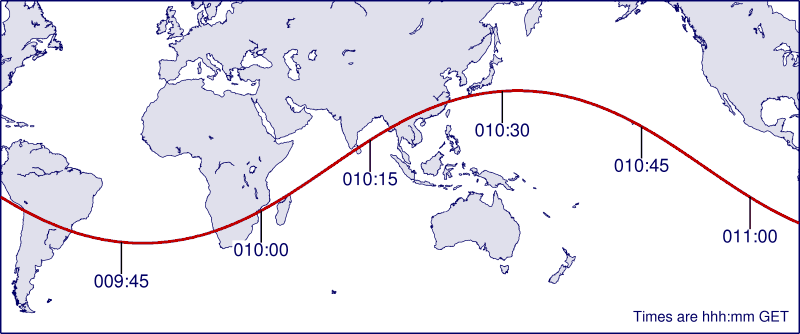
"This is Apollo Control at 9 hours, 56 minutes into the flight of Apollo 9. During the last pass over Hawaii at about 9:05 GET, the Flight Surgeon, Dr. John Ziegelschmidt, reported the following mean heart rates on the crew. He said that the Commander was registering 80 beats per minute, the Command Module Pilot registered 80 beats per minute, while the Lunar Module Pilot registered 68 beats per minute. The respiration rates were as follows: 20 breaths per minute for the Commander, 16 for the Command Module Pilot and 12 for the Lunar Module Pilot. The astronauts at that time were not yet resting. They were still doing some minor housekeeping duties in preparation for the rest cycle. In the meantime here at MSC we're maintaining a radio silence to give the crew the maximum opportunity for rest. In the area of the spacecraft systems, all of them are looking okay and they're being monitored by the Flight Controllers here in Houston. No anomalies occurring whatsoever. At 9 hours, 57 minutes into the flight with the spacecraft now heading across the tip of Africa, the lower part of Africa, on the seventh revolution, this is Apollo Control."
"This is Apollo Control at 10 hours, 51 minutes into the flight of Apollo 9. The spacecraft has moved out of range of the Hawaii tracking station. During that pass over Hawaii the Flight Surgeon was monitoring the astro-bioenvironmental tab as they call it, the vital signs and rates of the crew, and noted that all of their vital signs appeared to be within the tolerable limits. The Commander, for example, was indicating between 80 and 84 beats per minute. The Command Module Pilot showing approximately 60 beats per minute, and about 10 respirations per minute. Flight Surgeon assumes that the astronauts are still resting, perhaps another hour or so will be required before they can lapse into a sound sleep. Meantime, all of the systems on the spacecraft are reported operating well. Aa far as we're able to determine, the Commander and the Command Module Pilot are resting in the couches and the LM, the Lunar Module Pilot, evidently is in the sleep station. We assume that since we receive no biomedical data from the LM, the Lunar Module Pilot, on this pass. Incidentally, at approximately 10 hours, and 42 minutes, some 9 minutes or so ago, Dave Scott doubled his total flight time in space. He was a member of the Gemini 8 crew that had to reenter in the Pacific on March 16, 1966, after some 10 hours and 41 minutes of flight. He now has 10 hours, 54 minutes of flight. All systems seem to be working well. The astronauts are in their rest cycle and this is Apollo Control."
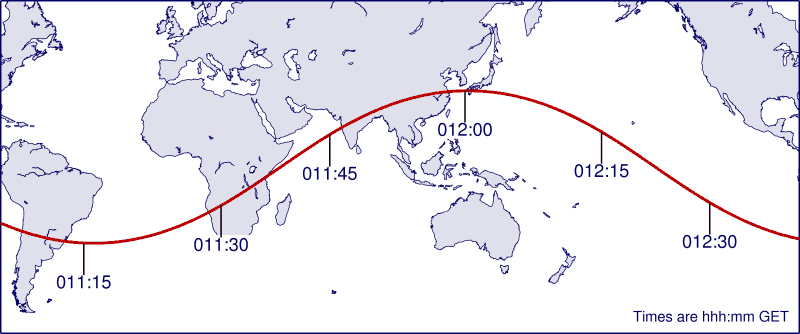
"This is Apollo Control at 11 hours, 50 minutes, into the flight of Apollo 9. At the present time the spacecraft is flying over India on the 8th revolution. A little earlier when the spacecraft was in range of Pretoria Tracking Station, the digital chart indicated that the astronauts were flying following parameters. Apogee was 126.6 nautical miles [234.5 km] and the perigee or low point was 108.1 nautical miles [200.2 km]. The altitude was about the same as earlier altutudes following the first SPS burn. Spacecraft speed at that particular time was in the neighborhood of 25,500 plus feet per second [7800 m/s]. At the present time the spacecraft systems are powered down, they still register okay here at mission control. Spacecraft cabin pressure is maintaining stability at 4.9 psia [33.8 kPa] at 11 hours, 51 minutes into the flight of Apollo 9, this is Apollo Control."
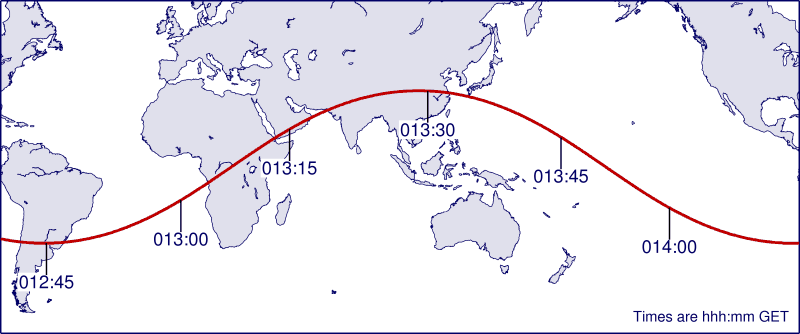
"This is Apollo control at 12 hours 50 minutes Ground Elapsed Time. During the Hawaii pass some 30 minutes ago the Gold team flight surgeon reported receiving data on the Lunar Module Pilot. Apparently astronaut Schweickart had moved from his sleep station into one of the couches. The LM pilot's mean heart beat registered 50 beats per minute and his mean respiration registered 10 breaths per minute leading the surgeon to conclude that he is dozing or beginning to sleep. No data was received on the commender or the Command Module Pilot during the Hawaii pass. Chances are they disconnected their biomed instrumentation according to the flight surgeon. Cabin temperature is 68°F [20°C] a very comfortable 68°. Meanwhile the count down clock shows 5 hours 36 minutes plus, indicating that that's the time left in the rest cycle for the Apollo 9 crew. The spacecraft at the present time is over the Atlantic Ocean east of South America coming up on the Ascension tracking station on this 9th revolution all systems still seem to be functioning very well. At 12 hours 52 minutes into the flight of Apollo 9 this is Apollo Control."
"This is Apollo Control. Spider and Gumdrop, that's the code name for the Apollo 9 spacecraft, are over the Pacific Ocean on this, the 9th rev. Apollo 9 moved out of the range of the Guam tracking station about 10 minutes ago, and it will be acquired by the tracking ship Mercury shortly. However, since the crew is resting, no attempt will be made to talk with them. During a recent pass the flight surgeon reported that TM data on astronaut Schweickart indicates that he is sleeping soundly. The countdown clock indicates that some 4 hours and 37 minutes of rest remain before the crew will be awakened in preparation for the second day's activities. Meanwhile, the flight controllers here at MCC in Houston monitoring the spacecraft report the systems appear to be functioning normally. At 13 hours 51 minutes GET, this is Apollo Control."
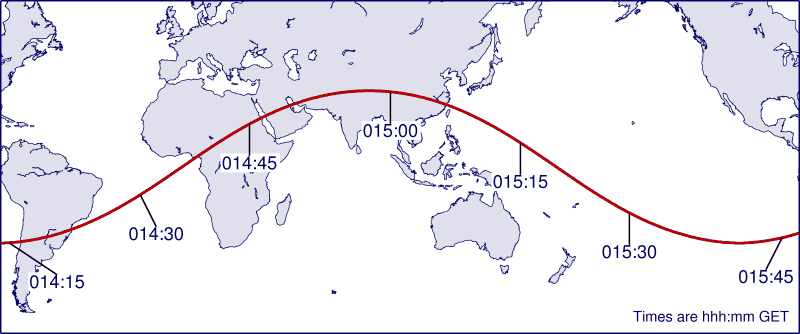
"This is Apollo Control 14 hours 50 minutes Ground Elapse Time. Here in Mission Control we've recently had a change of shift to the Orange team of flight controlers headed up by flight director Pete Frank. Apollo 9 fifteen minutes ago crossed over the Ascension Island tracking station in the South Atlantic at which time pulses of the system were felt on the ground so to speak by telemetry and all the systems are in pretty good shape. Flight surgeon John Zeigleschmidt reported that LM pilot Rusty Schweickart was not apparently sleeping very soundly because his heart rate fluctuated somewhat during the past indicating that he was staring [sic] in his sleep. Cabin pressure at the present time is holding at 4.9 pounds per square inch [33.8 kPa], with a the cabin temperature is 66°F [19°C]. The Apollo 9 spacecraft will cross over the tracking station at Guam at 8 minutes past the hour. At 14 hours 51 minutes Ground Elapse Time this is Apollo Control."
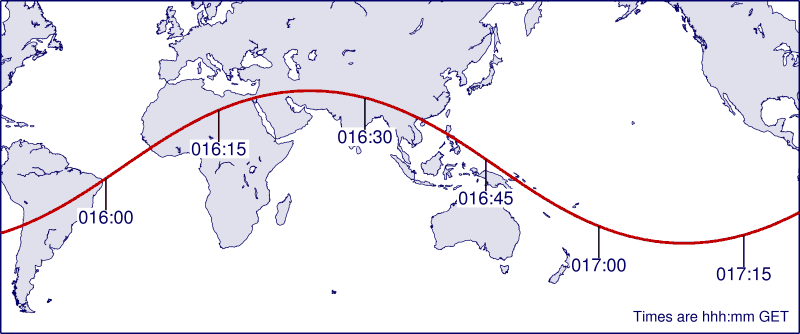
"This is Apollo Control 15 hours 50 minutes Ground Elapsed Time. Apollo 9 is just crossing the West Coast of the southern portion of South America at this time and should be beginning the eleventh revolution as it crosses the meridian of longitude of the launch point of Cape Kennedy. We have some two hours thirty-eight minutes until the Apollo 9 crew is awakened to begin the next day's activities. Among these activities will be service propulsion system burn number two which is scheduled at 22 hours 12 minutes and 03 seconds. This 850 foot-per-second [260 m/s] burn will be primarily out of plane however it will raise apogee by some 64 nautical miles [118 km]. The out-of-plane component of the burn will shift the orbital plane back to the East to improve tracking for the activities later in the mission, such as EVA and rendezvous. Most of these SPS burns as a matter of fact are out-of-plane for this reason and also to lessen the gross weight or mass of the spacecraft to improve the RCS LM rescue capability and for RCS de-orbit at the end of the mission. Here in the Mission Control Center, there's a cardboard mounted cartoon behind Pete Frank's console, the Orange Team flight director, It was drawn by Ed Pavelka who is the Gold Team flight dynamics officer. The cartoon says welcome to Manned Spaceflight to a Tenderfoot meaning flight director Pete Frank; this is his first time out as a flight director. We are coming up in approximately 12 minutes on the Ascension Island Tracking Station. Our present orbital measurements show a perigee of 108 nautical miles [200 km], apogee of 126.3 nautical miles [233.9 km], total weight of Gumdrop and Spider, the Command and Service Module and the docked Lunar Module, is now calculated at 90,569 pounds [41,081 kg]. At 15 hours 52 minutes Ground Elapsed Time, this is Apollo Control."
"This is Apollo Control 16 hours 50 minutes GET. Apollo 9 is presently over the island of New Guinea in the South Pacific and is within seconds of being acquired by the tracking ship Huntsville which is hove to just east of New Guinea. Earlier this revolution over the Acension Island pass Doctor Ken Beers reported that the biomedical telemetry beamed down from the spacecraft showed that Schweickart apparently was in a sound sleep. The Command Module Pilot and the Commander are in the sleep stations underneath the couches, the sleeping bags, where there's no telemetry available because of the way the biomedical instrumentation cabling is arranged, however the Command [sic] Module Pilot Rusty Schweickart is in the couch with biomedical telemetry available. It is likely that the two passes over the ship Huntsville and Mercury which almost overlap here in this eleventh revolution will be simply system status passes and no commentary or conversation with the crew is anticipated since it is likely that they are all still asleep. At 16 hours 51 minutes GET this is Apollo Control."